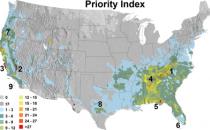SELC helps curb highway project’s harm to historic resources
SELC and our allies have secured important changes to plans for widening Interstate 66 in Northern Virginia that limit impacts on the Manassas National Battlefield Park. In the process, we have also helped avoid setting a harmful precedent for future highway projects near historic resources throughout the Southeast.
The Virginia Department of Transportation (VDOT) awarded a contract in 2016 to build express lanes along the busy I-66 corridor between Gainesville and the Capital Beltway. The final design plans included a proposal to build two “elevated access ramps” adjacent to the National Battlefield Park’s southern border to create an additional connection between the new express lanes and the main travel lanes of I-66. These roughly 30-foot high ramps were not in VDOT’s initial design and would have been highly visible from the park.
Along with the National Park Service and in concert with our partners, we raised strong concerns about the impacts of the ramps on the battlefield and insisted that the design change be reviewed under the National Historic Preservation Act—a critically important legal tool for protecting historic resources. In response, VDOT and the Federal Highway Administration ultimately undertook the review we requested.
As a result of the strong pushback, the plans were then revised to remove one of the ramps from the historic viewshed and to modify the second ramp so that more of it would be concealed by vegetation and terrain.
VDOT argued that with these changes and some loose commitments relating to design and screening, the project would not have an “adverse effect” on the park, such that no additional mitigation was required under the National Historic Preservation Act. The agency’s argument was largely based on the fact that other elements of modern development, like a cell tower, are already visible from this part of the viewshed.
We and our partners pushed back against this reasoning, pointing out its obvious “death by a thousand cuts” ramifications for Manassas National Battlefield Park and other historic landscapes. Significantly, the Virginia Department of Historic Resources agreed with us, and VDOT has now agreed to steps that will further reduce the project’s impacts.
While the ideal outcome would have been to have both ramps moved outside the viewshed or removed from the design altogether, the revised plans significantly reduce the scale of the intrusion. Just as important, we succeeded in countering a harmful interpretation of legal requirements that could have been used to justify highway impacts on historic resources across our region.

